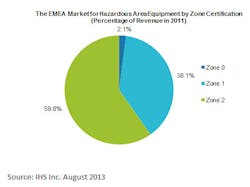In a study of hazardous area equipment used in Europe, the Middle East and Africa (EMEA) last year, IMS Research (now part of IHS) found that two-thirds of it was for the oil and gas industry. Although it’s well known that oil and gas figures significantly in hazardous area equipment, the extent of the market share still came as a surprise, according to John Morse, senior automation market analyst with IHS.
The 2009 edition of the same report showed oil and gas accounting for about half the revenues at that time, so the 2013 results mark a significant increase. IMS notes the growing volume of legislation in the industry as a key factor. “There is a steady flow of new legislation being introduced,” Morse said, adding that more notably the legislation is being more strictly applied, particularly in the lower-risk environments.
“Disasters in oil and gas installations get reported by the global media in seconds, and the consequences can be catastrophic for the companies involved,” Morse said. “The result is that site operators are minimizing exposure wherever possible. In situations where there is any risk of explosion, no matter how small, ensuring certificates proving compliance with the relevant hazardous area legislation are logged and readily accessible, just in case.”
The figure shows the market revenue share of EMEA in hazardous area equipment by zone certification.
Leaders relevant to this article:

